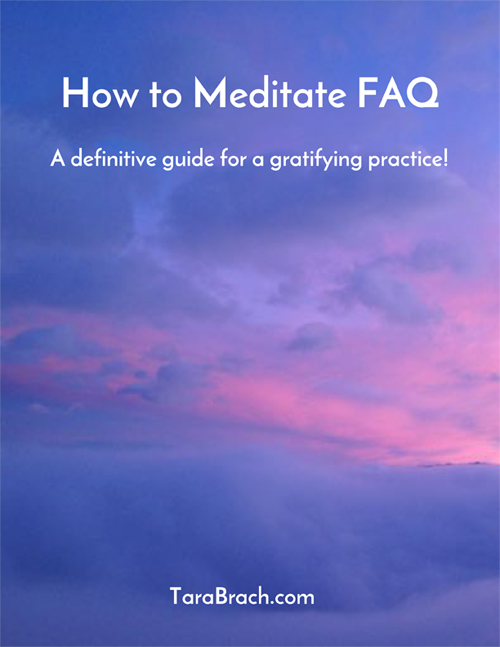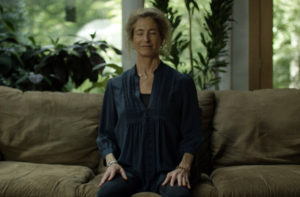by Tara Brach (This article originally was published in Awakening Mind)
There is one thing that, when cultivated and regularly practiced, leads to deep spiritual intention, to peace, to mindfulness and clear comprehension, to vision and knowledge, to a happy life here and now, and to the culmination of wisdom and awakening. And what is that one thing? It is mindfulness centered on the body. ~ The Buddha, Anguttara Nikaya
Awareness of sensations is considered the first foundation of mindfulness because whatever we experience—feelings, emotions, thoughts and sensory perceptions—also arise as sensations in our body. When mindful of our body, we open to the changing stream of sensations without grasping or resistance. The experience might be fear or joy, it might be the intensity of aliveness, or it might be numbness. The Buddha makes clear that this mindfulness is not a distanced kind of witnessing. He says we should “observe sensations within sensations.” This means not imagining our hand, for instance, but actually directly feeling from the inside the energy that is our hand, as it is in any given and changing moment. We are training to experience the body from the inside out.
When we first begin this practice, we usually notice what the Buddha described as “seeing the waterfall” of thoughts—judging, commenting, worrying, planning, fantasizing. This waterfall, energized by our basic conditioning of wanting and fearing, continuously carries us away from the moment’s experience. When sensations become unpleasant, our first reaction, like a flinch, is instantaneous and unconscious—we try to get away from what we don’t like. We then compound this reaction by taking the unpleasantness personally. If we are not mindful, the bare experience of sensations can, within moments, proliferate into suffering.
The chronic fatigue and illness my friend Louise suffered from had her trapped in feeling that she was basically flawed. Every time her body became achy or tired, she immediately began to condemn herself for how she wasn’t taking care of herself properly. Assuming that sickness was a reflection of her weak character, each cycle of physical illness deepened her feelings of shame. She fearfully fast-forwarded into the future—“I’ll never get well;” and easily felt swamped in depression—“This will never change.” Louise used food, mystery novels and obsessive thinking to leave her body and avoid feeling the pain and fear. On some days she felt as if being sick and defective defined her entire existence.
Reacting against unpleasant sensations is a muscle—it gets stronger with exercise. As Louise experienced, our past habits of reacting color how we perceive and respond to whatever is arising in the present moment. Rather than simply feeling the sensations of the headache she had at a particular moment, Louise was reacting to something compounded by historical experience. A headache meant she was flawed and that her life would always be miserable. Each new arising of unpleasant sensation inclined her to repeat the same sequence of reactions: Pain, flawed self, fearful self, depressed self.
The chain of reactivity to unpleasant sensations is most extreme if we have been traumatized. After the terror and wounding of such experiences, the reflex to push away pain goes into overdrive, severing us from major parts of our physical and emotional life. Over the years, this buried fear and pain is periodically unleashed. Our partner might raise her voice in irritation, and the full force of historical wounding—all the terror or rage that lives in our body—can be triggered. Whether or not there is any present danger, we feel absolutely at risk, and compelled to find a way to get away from the pain.
Even if we haven’t been traumatized, we have strong conditioning to disconnect from our physical experience. In contrast to indigenous cultures that are more at home in the physical world, our western culture views nature, and our living, dying bodies, as something to mistrust. Not only do we try to “kill” pain, we control and subdue pleasure as well. Early on we found out that our natural urges—being exuberant and wild, sexual and aggressive—were frowned upon. We learned that to be good and belong we had to get rid of certain feelings. In order to avoid rejection, we cut off from the full aliveness in our body. For many, it is not until we become middle aged that we realize we have lost touch with our wildness and vulnerability, our playfulness and vitality.
Healing by Coming Back to Our Body:
We heal by reconnecting to the parts of our experience that we habitually push away. Yet because we feel so unsafe, especially in the aftermath of trauma, opening mindfully to our physical experience may be a very gradual process. We begin by learning to put our toe in the river, and then, compassionately, step back when necessary. We do what we can to set a conducive inner environment—relaxing our body, sending ourselves messages of kindness. Sometimes we need the support of a meditation teacher, healer or therapist in discovering a way of easing into the raw sensations that we have been avoiding.
What happens when we bring a clear and kind attention directly to our sensational experience? If we are angry, what happens when we simply open to the heat and explosive pressure of anger?As we recognize the intensity of these sensations with an open awareness, the energy, rather than getting trapped, continues on its natural course. The knots of anger unfold, transform and eventually dissolve. This does not necessarily happen right away. Like the weather, anger naturally comes and goes, but it might first become more turbulent. We might find that by making room for today’s anger, we open the door to old buried anger, perhaps to an even deeper reactive rage linked to a painful past. Or we might find that the feeling of anger turns into hurt and fear and loneliness.
In both Buddhist psychology and Western experiential therapy, an accepting awareness of sensations is central to the alchemy of transformation. Emotions, a combination of physical sensations and the stories we tell ourselves, continue to cause suffering until we experience them where they live in our body. If we bring a steady attention to the immediate physical experience of an emotion, past sensations linked to it are “de-repressed.” Layers of historic hurt and anger may begin to play themselves out in the light of awareness. By releasing the charged pockets of historical pain, we become increasingly able to meet new situations with a wakeful and fresh awareness. As we bring a gentle attention to our body, we reclaim our life and our spirit. We discover, as Rumi writes, that “The cure for the pain is in the pain.”
Seeing Life As It Is:
When asked to describe her spiritual practice, a Zen nun from fifteenth- century Japan responded, “I meet life with my whole body.” Awareness of sensations brings us fully into the present moment and allows us to directly see the nature of our experience. When we meet as pure sensation whatever arises, we see clearly how everything is constantly changing; how there is no self causing sensations to arise, no self that sensations happen to. They arise and pass on their own. By attending to the life of our body, we begin to see that our experience of sensations is part of belonging to this natural world. This entire universe is made up of changing, moving energies and our bodies are part of that dance.
Seeing this was a transfiguring experience for Louise. One day, after walking along the banks of the Potomac river, she found a spot to sit and meditate. As she became still, she could feel the firm ground under her, hear the sounds of birds and moving water, see the great sycamores leaning out over the river. When the inevitable tiredness and aches in her body appeared, instead of condemning them and herself in her usual way, she opened her eyes and looked around. Still feeling her body from the inside, Louise also included in her awareness the earth and sky, the brightness of the day and sounds of the water against rock. Her body shared the rocky hardness, mossy tenderness and firm pressure of the earth. She felt how her body was pulsing, vibrating, changing like the swirling currents and eddies in the river. She belonged to the earth, and the sensations of pain she was feeling were part of the whole natural process of life. Her pain was the earth’s pain.
As Louise released the weighty layers of self-judgment surrounding her sickness, she began regarding herself with a deep tenderness. “I felt free to be a caretaker of the earth,” Louise told me. “The sensations of hurt and fear were there, and so were the wild rushing water and the leaves dancing in the breeze. All of it was living in my heart.” By recognizing that the sensations of pain and shame and fear were not personal, Louise was able to relax into the open awareness that lets life simply unfold.
In his poem “Hokusai Says,” Ken Keyes guides us on this path of seeing aliveness and, with kindness, letting be:
It matters that you care.
It matters that you feel.
It matters that you notice.
It matters that life lives through you…Look, Feel, let life take you
By the hand.
Let life live through you.
In the moments when we wakefully let be, we can experience life as it is. As Hakuin Zenji writes, “This very place is the Lotus Land, this very body, the Buddha.” The Lotus Land is the cherished place of awakening that is always here in the present moment. When we meet life with our whole body, we are the Buddha—the awakened one—beholding the changing steam of sensations, feelings and thoughts. Everything is alive, the whole world lives inside us. As we let life live through us, we experience the boundless openness of our true nature.

